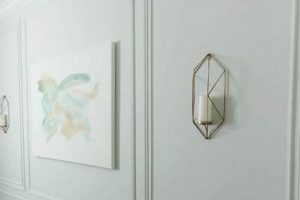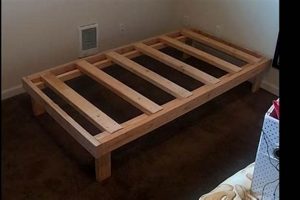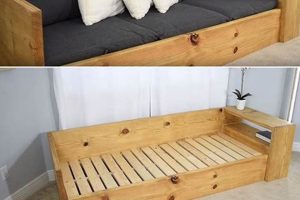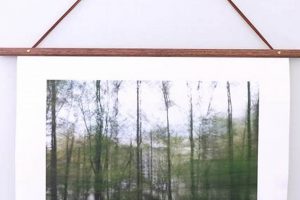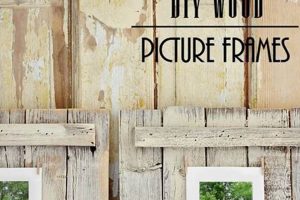The creation of picture holders from repurposed corrugated fiberboard represents a resourceful and economical approach to home decor. These structures provide a lightweight and customizable alternative to traditional manufactured options. An example includes utilizing cereal boxes or shipping containers to construct a border for displaying photographs or artwork.
Employing recycled materials in crafting decorative elements offers environmental advantages and cost savings. Historically, individuals have turned to accessible resources for practical solutions, and this craft aligns with a broader movement towards sustainability and personalized expression. The practice fosters creativity and reduces waste, contributing to a more conscious lifestyle.
The following sections will detail the materials required, the step-by-step process involved, design considerations, and various embellishment techniques for constructing these bespoke displays.
Essential Construction Guidelines
The following guidelines provide insights into achieving optimal results when fabricating picture supports from reclaimed paperboard. Adherence to these recommendations can improve structural integrity and aesthetic appeal.
Tip 1: Material Selection: Prioritize denser corrugated board for increased durability. Examine the chosen material for existing creases or damage, which may compromise the frame’s stability.
Tip 2: Precision Cutting: Employ a sharp utility knife and a metal ruler to ensure clean, accurate cuts. Consider using a cutting mat to protect the work surface and maintain blade sharpness.
Tip 3: Accurate Measurement: Precisely measure the artwork or photograph intended for display before cutting the frame components. Account for any overlap required to secure the image within the structure.
Tip 4: Strong Adhesion: Select an appropriate adhesive, such as hot glue or a strong craft glue, to bond the frame elements securely. Allow sufficient drying time for the adhesive to fully set before handling the finished piece.
Tip 5: Reinforcement Techniques: Reinforce the corners of the structure with additional cardboard pieces or tape to prevent separation and enhance long-term stability.
Tip 6: Surface Preparation: Prepare the surface for decoration by lightly sanding any rough edges and applying a primer if necessary. This ensures better adhesion of paint or other decorative materials.
Tip 7: Consider Backing Support: Implement a cardboard backing to provide stability and protection for the artwork. Secure the backing with adhesive or small fasteners.
Careful execution of these guidelines will contribute to the creation of sturdy, visually appealing display pieces.
The subsequent sections will explore decorative techniques and advanced construction methods for further customization.
1. Material selection
Material selection is a foundational element in the creation of picture holders from repurposed corrugated fiberboard. The choice of cardboard directly influences the finished item’s durability, aesthetic quality, and overall suitability for its intended purpose.
- Cardboard Density
The density of the cardboard is a primary determinant of the frame’s strength. Denser cardboard, typically found in thicker shipping boxes, provides greater resistance to bending and warping. This is especially crucial for larger frames or those intended to support heavier artwork. Lighter weight cardboard, such as that used in cereal boxes, may be suitable for smaller, lightweight items, but will require additional reinforcement.
- Corrugation Type
Corrugation refers to the fluted inner layer of cardboard. Different corrugation types (A, B, C, E, F, with A being the thickest and F being the thinnest) offer varying degrees of cushioning and stacking strength. A frame constructed from cardboard with a higher corrugation profile (e.g., A or B) will generally be more rigid than one made from a thinner profile (e.g., E or F). The corrugation direction is also important; aligning the corrugation vertically can enhance the frame’s ability to withstand vertical loads.
- Surface Condition
The surface condition of the cardboard impacts its aesthetic appeal and its ability to accept decorative treatments. Cardboard with a clean, unblemished surface provides a better base for painting, gluing, or applying decorative papers. Avoid using cardboard with excessive printing, stains, or damage, as these imperfections may be difficult to conceal.
- Recycled Content and Environmental Impact
The environmental appeal of crafting picture supports from recycled materials is heightened when considering the specific source. Opting for cardboard sourced from post-consumer recycled content further reduces the environmental footprint of the project. Selecting materials responsibly contributes to a circular economy and minimizes waste.
The careful consideration of these material properties is crucial in ensuring the construction of robust, visually pleasing, and environmentally conscious picture holders from reclaimed corrugated board. Neglecting these factors can result in a final product that is structurally weak or aesthetically unappealing.
2. Cutting precision
The accuracy of cuts represents a foundational element in constructing picture supports from reclaimed corrugated board. The dimensional integrity of these structures is directly contingent upon precise execution. Deviations from specified measurements can compromise the overall aesthetic, structural stability, and the ability of the structure to correctly house the intended artwork. Imprecise cuts lead to misaligned corners, uneven borders, and potential warping. These defects can detract significantly from the final presentation. In contrast, accuracy in cutting translates to a refined appearance and improved longevity.
Examples of the impact are readily observable. A 1/8-inch discrepancy in the length of one side can cause a noticeable skew in the finished form. When creating mitered corners, precise 45-degree angles are essential for creating a flush, professional joint. Inadequate adherence to cutting guidelines necessitates corrective measures, often involving additional material and labor. This includes the application of filler, adhesives, or structural reinforcements. Such remedial work not only consumes additional resources but may also compromise the aesthetic uniformity of the finished work.
In summation, achieving dimensional accuracy is not merely an aesthetic consideration but a critical component in the creation of structurally sound and visually pleasing picture holders from recycled board. Mastery of cutting techniques is therefore essential for anyone engaging in this form of sustainable craft. Failure to maintain precision results in a diminished product that fails to effectively serve its intended function. Furthermore, the benefits of recycling materials are diminished when significant material and effort are wasted due to inaccuracies, which is not the intention of crafting picture holders from reclaimed corrugated board
3. Adhesive strength
The structural integrity and longevity of picture holders crafted from repurposed corrugated board are fundamentally dependent upon the adhesive strength employed in their construction. The adhesive serves as the primary binding agent, uniting individual components into a cohesive, self-supporting structure. A deficiency in adhesive performance can lead to premature failure, undermining the aesthetic value and utility of the finished item.
- Surface Compatibility
Adhesives exhibit varying degrees of compatibility with different cardboard surfaces. Glossy or heavily printed surfaces may impede proper adhesion, necessitating surface preparation techniques such as sanding or priming. Selection of an adhesive formulated for porous materials, such as paper and cardboard, is critical for establishing a strong bond. Consideration of the specific surface characteristics of the chosen corrugated board is paramount.
- Load-Bearing Capacity
The load-bearing capacity of the adhesive directly impacts the frame’s ability to support the weight of the artwork and any associated backing materials. Frames designed to hold heavier items necessitate adhesives with high tensile strength and shear resistance. Application techniques, such as ensuring complete coverage and adequate clamp time, are essential for maximizing the adhesive’s load-bearing potential.
- Environmental Resistance
Adhesive bonds are susceptible to degradation from environmental factors such as humidity, temperature fluctuations, and ultraviolet radiation. The selection of an adhesive with appropriate environmental resistance is particularly important for picture holders intended for display in areas prone to such conditions. Moisture-resistant adhesives, for example, are advisable for use in bathrooms or kitchens.
- Long-Term Durability
The long-term durability of the adhesive bond determines the lifespan of the frame. Adhesives that exhibit brittleness or a tendency to lose adhesion over time can lead to structural weakening and eventual failure. Consideration of the adhesive’s aging properties and its susceptibility to creep or deformation under sustained load is essential for ensuring the long-term stability of the structure.
A comprehensive understanding of the interplay between surface compatibility, load-bearing capacity, environmental resistance, and long-term durability is indispensable for achieving optimal adhesive performance in the creation of resilient and visually appealing supports from repurposed corrugated materials. Incorrect adhesive selection or improper application can negate the benefits of material selection and cutting precision, resulting in an inferior end product.
4. Structural support
Structural support is a critical consideration in the fabrication of picture displays from recycled corrugated board. The inherent properties of cardboard necessitate thoughtful engineering to ensure the final product can adequately bear the weight of artwork and withstand external forces. Without adequate support, the structure may warp, buckle, or collapse, rendering it unsuitable for its intended purpose.
- Corner Reinforcement
Corners represent points of concentrated stress within a rectangular structure. Reinforcing the corners of a recycled board frame with additional layers of cardboard or specialized corner brackets significantly increases its resistance to deformation. Mitered corners, while aesthetically pleasing, are particularly vulnerable and often require substantial reinforcement. The absence of robust corner supports can lead to premature failure, especially when the frame is subjected to even moderate stress.
- Backing Board Integration
The inclusion of a backing board serves multiple purposes, including providing a stable surface for mounting artwork and contributing to the overall structural rigidity of the frame. A rigid backing board, securely affixed to the frame, distributes weight evenly and prevents the frame from twisting or bowing. The choice of backing board material, such as thick cardboard or foam core, impacts the degree of support provided. Inadequate backing can result in sagging or warping, particularly for larger picture displays.
- Internal Bracing
Internal bracing refers to the addition of supporting elements within the frame structure. These elements, typically constructed from strips of cardboard, are strategically positioned to reinforce areas prone to bending or buckling. For example, a long, slender frame may benefit from vertical or horizontal bracing along its length. Proper placement of internal bracing can dramatically enhance the frame’s load-bearing capacity and resistance to deformation, without significantly increasing its overall weight.
- Edge Strengthening
The edges of a board frame are susceptible to damage from handling and environmental factors. Strengthening the edges with edge banding or by folding over and gluing the cardboard can significantly improve their durability. Edge strengthening also prevents the corrugated core from being exposed, which can detract from the frame’s aesthetic appeal. A well-reinforced edge provides a more robust and professional finish.
The implementation of these structural support techniques is essential for producing durable and aesthetically pleasing picture holders from recycled board. Neglecting these considerations can result in a final product that is structurally weak and prone to failure, undermining the benefits of utilizing recycled materials. Prioritizing structural integrity is paramount in achieving a high-quality and long-lasting display piece.
5. Decorative finish
The decorative finish represents a crucial determinant in the overall aesthetic impact of picture supports constructed from recycled corrugated board. It transcends mere ornamentation, serving as a mechanism to integrate the utilitarian structure within a given environment. The choice of finish directly influences the perceived value and the visual harmony of the frame in relation to the artwork it contains and the surrounding space. Unrefined cardboard surfaces, while inherently sustainable, often lack the visual sophistication required for formal settings. Therefore, the application of appropriate decorative techniques becomes essential in elevating the status of these frames from simple craft projects to refined display elements.
Numerous decorative approaches are available, each imparting a distinct character. Painting, for example, allows for complete color customization and the potential to replicate the appearance of more expensive materials. The application of patterned papers or fabrics provides textural and visual interest, enabling a closer alignment with existing dcor. Surface treatments such as varnishing or sealing not only enhance the aesthetic appeal but also provide a protective barrier against moisture and physical damage, prolonging the lifespan of the frame. In professional contexts, consider the use of archival-quality materials for the decorative finish to ensure that the frame itself does not contribute to the degradation of the displayed artwork over time. For instance, using acid-free paints and sealants is advisable when framing valuable photographs or documents.
In conclusion, the decorative finish is an integral component of repurposed board picture displays, influencing both their aesthetic and functional attributes. By carefully selecting and applying appropriate decorative techniques, the inherent limitations of the base material can be overcome, resulting in a visually appealing and durable display solution. The ultimate goal is to create a cohesive presentation that complements the artwork and enhances the overall ambiance of the space. Failure to adequately address the decorative finish can negate the benefits of sustainable construction and result in a product that fails to meet aesthetic expectations.
Frequently Asked Questions
The following addresses common inquiries regarding the construction, durability, and suitability of picture holders made from recycled corrugated board.
Question 1: What types of cardboard are most suitable for frame construction?
Dense corrugated board, typically sourced from shipping containers, provides superior structural support. Flimsier cardboard, such as that used in cereal boxes, may require additional reinforcement to ensure adequate stability.
Question 2: How can mitered corners be effectively reinforced?
Mitered corners are inherently weak points and necessitate robust reinforcement. Applying multiple layers of cardboard to the joint and securing them with a strong adhesive is recommended. Corner brackets or gussets can further enhance stability.
Question 3: What adhesives provide the strongest bonds for corrugated board?
Hot glue guns, construction adhesives, and certain epoxy formulations offer strong adhesion to cardboard. The selection of adhesive should consider the material’s porosity and intended load-bearing capacity.
Question 4: How can warping be prevented in larger frames?
Warping can be minimized by using thicker cardboard, incorporating internal bracing, and ensuring a rigid backing board is securely attached. Proper storage and handling are also critical to prevent deformation.
Question 5: Are these frames suitable for displaying valuable or archival artwork?
Frames created from repurposed board may not offer the archival protection required for delicate or valuable artwork. Consider using acid-free backing materials and sealing the cardboard to prevent off-gassing. Consult with a professional framer for optimal preservation solutions.
Question 6: How can the frames be protected from moisture and environmental damage?
Applying a sealant or varnish provides a protective barrier against moisture and UV radiation. Select a sealant that is compatible with the chosen decorative finish. Avoid displaying the frames in areas with high humidity or direct sunlight.
Proper material selection, construction techniques, and environmental considerations are crucial for creating durable and aesthetically pleasing picture holders from recycled board.
The next section will explore advanced design considerations and customization techniques for enhancing the appearance and functionality of these frames.
Conclusion
The preceding discussion has elucidated the multifaceted aspects of diy cardboard frames, encompassing material selection, cutting precision, adhesive strength, structural support, and decorative finishes. A comprehensive understanding of these elements is paramount for achieving optimal results in the creation of visually appealing and structurally sound picture displays utilizing repurposed corrugated board.
The sustainable nature of this craft underscores its significance in an era of increasing environmental consciousness. Continued exploration and refinement of techniques will further enhance the potential of diy cardboard frames as a viable and aesthetically pleasing alternative to traditional framing methods. Mastery of these techniques empowers individuals to create personalized and environmentally responsible displays for cherished artwork and memories.


